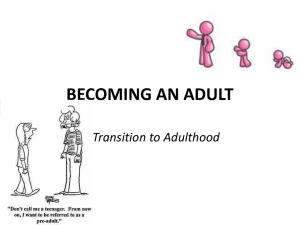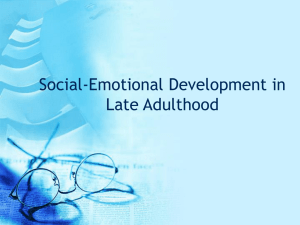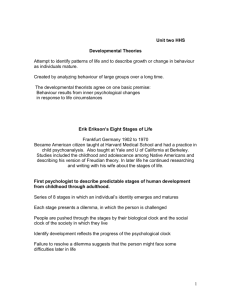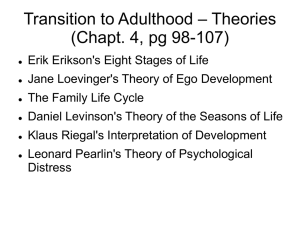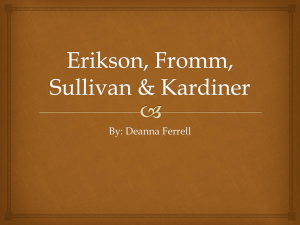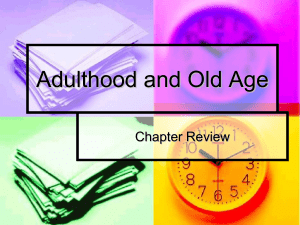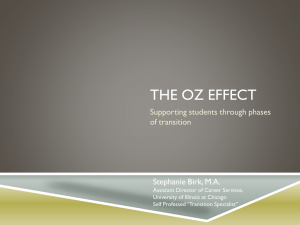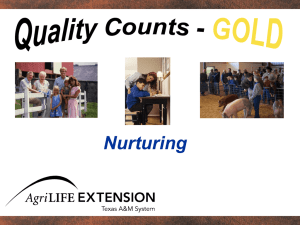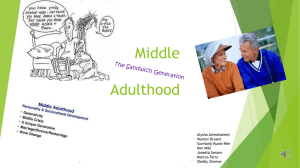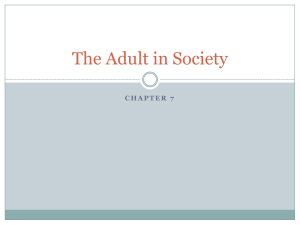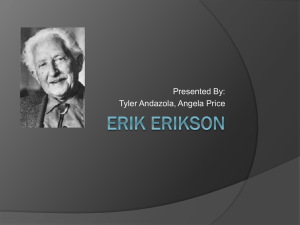Developmental Theories 1
advertisement
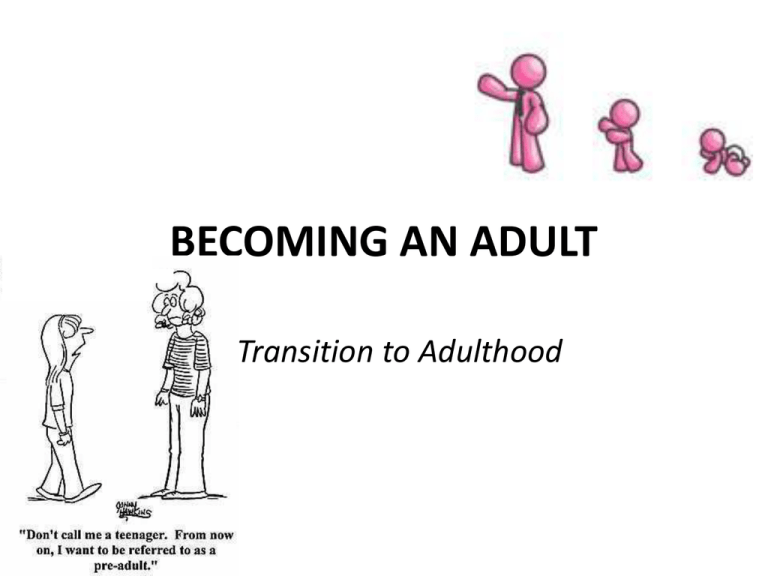
BECOMING AN ADULT Transition to Adulthood The Transition to Adulthood • Becoming an adult is a process • This process begins in childhood and continues until you are an adult: – in your own eyes – in the eyes of your parents – by the law – by the society you live in The Transition to Adulthood • An individual’s development is a gradual process • It is marked by distinct and significant milestones Ex. Puberty, graduation, getting your driver’s licence, marriage and adulthood • Rites of Passage: rituals that celebrate an individual’s passage from one stage of life to the next • Stages of life are not the same in all societies 4 Stages of the Hindu Life Cycle 1) Brahmacharya – youth – begins at about age 10 and lasts for about 10 years – before this stage, a Hindu child is not considered to be fully formed yet – primary expectations of the individual is to remain celibate and become educated, particularly in religious matters 4 Stages of the Hindu Life Cycle 2) Grihastha – marked by marriage – Hindu men and women are expected to raise and care for their family and do what is economically necessary to ensure their children prosper 4 Stages of the Hindu Life Cycle 3) Vanaprastha – means service – once the children have reached the 2nd Stage, Hindu parents enter this 3rd Stage – individuals are expected to focus more on religious beliefs and rituals and begin to separate themselves from their families – gradually give away their material wealth and possessions to prepare for the next stage 4 Stages of the Hindu Life Cycle 4) Sannyasa – retirement – some Hindus may live as religious sadhus (holy men) and sadhvi (holy women) depending on the charity of others in the community – live without any personal attachment to family or friends • This cycle repeats for their children generation after generation The Pace of Development • Progress from one stage of life to another has been described as the interaction of several clocks, each ticking away at its own pace • The age of majority reflects the chronological clock and defines adulthood in terms of the number of years since birth • The physical changes that result in sexual maturity and the attainment of full adult size and strength are determined by the biological clock The Pace of Development • The psychological clock reflects how the brain is developing as individuals acquire new mental processes and more mature ways of understanding the world • The social clock sets the timetable for society’s expectations concerning when certain events should occur in the lives of individuals • Becoming an adult is probably determined more by the social clock than by any other Erik Erikson • 1st psychologist to describe predictable stages of human development from childhood through adulthood • Developed 8 stages in which an individual’s identity emerges and matures • Each stage represents a conflict, in which the person is challenged by new situations and circumstances in life Erik Erikson • Individuals are pushed through the stages by their biological clock and by the social clock of the society in which they live • Identity development reflects the progress of the psychological clock • By resolving each conflict at each stage, the individual acquires the basic strength needed to meet the challenges of the next stage in life • Failure to resolve the conflict results in difficulties the individual will face later in life Erik Erikson’s 8 Psychosocial Stages of Development Stage 1 Ages: Infancy (birth – 18 months) Basic Conflict: Trust vs. Mistrust Important Event: Feeding Outcome: Children develop a sense of trust when caregivers provide reliability, care, and affection. A lack of this will lead to mistrust. Erik Erikson’s 8 Psychosocial Stages of Development Stage 2 Ages: Early childhood (18 months – 3 years) Basic Conflict: Autonomy vs. Shame & Doubt Important Event: Toilet Training Outcome: Children need to develop a sense of personal control over physical skills and a sense of independence. Success leads to feelings of autonomy, failure results in feelings of shame and doubt. Erik Erikson’s 8 Psychosocial Stages of Development Stage 3 Ages: Preschool (3 – 6 years) Basic Conflict: Initiative vs. Guilt Important Event: Exploration Outcome: Children need to begin asserting control and power over the environment. Success in this stage leads to a sense of purpose. Children who try to exert too much power experience disapproval, resulting in a sense of guilt. Erik Erikson’s 8 Psychosocial Stages of Development Stage 4 Ages: School age (6 – 12 years) Basic Conflict: Industry vs. Inferiority Important Event: School Outcome: Children need to cope with new social and academic demands. Success leads to a sense of competence, while failure results in feelings of inferiority. Erik Erikson’s 8 Psychosocial Stages of Development Stage 5 Ages: Adolescence (12 – 18 years) Basic Conflict: Identity vs. Role Confusion Important Event: Social Relationships Outcome: Teens need to develop a sense of self and personal identity. Success leads to an ability to stay true to yourself, while failure leads to role confusion and a weak sense of self. Erik Erikson’s 8 Psychosocial Stages of Development Stage 6 Ages: Young Adulthood (18 – 40 years) Basic Conflict: Intimacy vs. Isolation Important Event: Relationships Outcome: Young adults need to form intimate, loving relationships with other people. Success leads to strong relationships, while failure results in loneliness and isolation. Erik Erikson’s 8 Psychosocial Stages of Development Stage 7 Ages: Middle Adulthood (40 – 65 years) Basic Conflict: Generativity vs. Stagnation Important Event: Work and Parenthood Outcome: Adults need to create or nurture things that will outlast them, often by having children or creating a positive change that benefits other people. Success leads to feelings of usefulness and accomplishment, while failure results in shallow involvement in the world. Erik Erikson’s 8 Psychosocial Stages of Development Stage 8 Ages: Maturity (65 years – death) Basic Conflict: Ego Integrity vs. Despair Important Event: Reflection on Life Outcome: Older adults need to look back on life and feel a sense of fulfillment. Success at this stage leads to feelings of wisdom, while failure results in regret, bitterness, and despair. Jane Loevinger’s Theory of Ego Development • Identified 10 stages in the formation of the ego • Ego = a term introduced by Freud meaning the understanding of self • Begins in infancy with the understanding that you are an individual separate from your mother • Full ego development = autonomous self Loevinger’s Ego Development • Autonomous Self = Being a self-reliant person who accepts oneself and others as multifaceted and unique • Understanding of self is the centre of human development • Few individuals ever achieve full ego development, however we all strive for it • Progress from one stage to another is determined by psychological clock Loevinger’s Ego Development • Young adults between conformist stage & conscientious stage • Conformist stage – view life in stereotypical ways in an attempt to classify human experience so they can belong • Self-aware – understand & accept individual differences ; distinguish variation in feelings and opinions that make us unique • Conscientious stage – able to appreciate others as individuals in reciprocal relationships The Family Life Cycle Framework • Early adulthood is a stage in which individuals are launched from their families of origin • Parents and children must separate from one another so that young adults can be selfsufficient for themselves prior to forming a new family The Family Life Cycle Framework • Young adults must master 3 tasks to become self-sufficient adults 1) Individuation – forming an identity separate from that of their family origin 2) Develop new intimate relationships with peers outside the family to provide the social and emotional support they need 3) Commit to a career or workplace role The Family Life Cycle Framework How do parents help their children become selfsufficient? • Relationship between parent and child must become less hierarchical so the young adult can accept responsibility for their decisions • Parents must accept differences in opinion and decisions the young adult makes • Parents must accept that the child is forming new intimate relationships with others which will become the new primary relationship The Family Life Cycle Framework Limitation: • Focuses on early adulthood in relation to marriage and parenthood • In the mid-20th century, when the theory was developed, most Canadians married and had children • Although this is not the trend today, research shows it is still the expectation for most Canadians Daniel Levinson’s Theory of the Seasons of Life • Psychologist • Proposed that the life course evolves through seasons lasting about 25 years each • The era of early adulthood lasts 25 years, begins near the end of high school at 17 years old until middle age in the early 40’s Daniel Levinson’s Theory of the Seasons of Life Early Adult Transition - 17 to 22 years old • an individual must leave behind adolescent life and begin to prepare an adult life structure (the plan or design of an individual’s life) • separation from the family of origin, emotional not physical separation • modify or end relationships associated with an adolescent life to make way for new adult relationships • complete education and/or start work • make some preliminary plans for adult life Daniel Levinson’s Theory of the Seasons of Life Entering The Adult World - 22 to 28 years old • time for building one’s life structure • 4 Major Tasks of this period 1) Forming a Dream and giving it a place in the life structure 2) Forming mentor relationships 3) Forming an occupation 4) Forming love relationships, marriage and family Daniel Levinson’s Theory of the Seasons of Life Entering The Adult World • Dream: the individual’s sense of self in the adult world and is the core of the life structure • Nature of the Dream will vary, but most describe some combination of occupational, family and community roles • A Dream can be precise or mythical Daniel Levinson’s Theory of the Seasons of Life Entering The Adult World • Choices of occupation, love relationships and peer relationships may support the Dream • Many individuals develop relationships with mentors who support their Dreams and facilitate their progress Daniel Levinson’s Theory of the Seasons of Life Entering The Adult World • Young adults build and test a preliminary life structure that integrates work, love and community to attain their Dreams • The challenge is to balance the creative exploration of various options for their life structure with a desire to make a commitment to a life structure that supports their Dream Daniel Levinson’s Theory of the Seasons of Life Entering The Adult World • The problem is that until individuals begin to live out the life structure, they do not know all of the possibilities • Yet without some commitment to the choices they have made, it is not possible to determine whether the life structure might be realistic or satisfying Daniel Levinson’s Theory of the Seasons of Life Age 30 Transition - 28 to 33 years old • Individuals re-evaluate the life structures that they formed in their early twenties to determine whether they are living out their dreams • Inner voice: “If I am to change my life-if there are things in it that I want to modify or exclude, or things missing I want to add-I must now make a start, for soon it will be too late” Daniel Levinson’s Theory of the Seasons of Life Age 30 Transition • As individuals adjust their life structures, individuals might choose to marry or to get a divorce, to have children, or to change jobs at this time • Time to “get real,” after testing their early choices for a few years before settling down in their 30s
